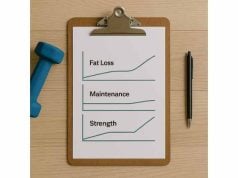
A calorie deficit is a tool, not a lifestyle. Used well, it helps you lose fat while protecting muscle, mood, and performance. Used too long, it erodes sleep, training, and adherence until progress stalls. The real skill is knowing when to keep cutting and when to hold maintenance so results keep stacking over months, not just weeks. This guide lays out practical timelines, objective checkpoints, and clear “pause” signals. You will learn how to run effective cuts, structure diet breaks, and decide whether to adjust calories or step away from the deficit for a short phase. If you hit a stall mid-process, keep our concise plateau troubleshooting guide open while you read.
Table of Contents
- How long should you stay in a deficit?
- Signs it’s time to pause
- How to take a diet break
- Adjust or pause during stalls?
- Who should pause sooner
- Performance, NEAT and recovery metrics
- Evidence and timelines
- Frequently Asked Questions
How long should you stay in a deficit?
There is no single “right” length for a fat-loss phase, but there are useful ranges. Most people do best with 8–12 weeks of focused cutting before a 1–4 week maintenance block. Shorter cuts—4–6 weeks—work well when life is busy or stress is high. Longer cuts—12–16 weeks—are possible, but only if sleep, steps, and training quality stay solid and hunger remains manageable.
Why length matters
- Physiology adapts. Appetite rises; spontaneous movement (NEAT) tends to fall; training can feel harder. Moderate, time-boxed cuts limit this drift.
- Psychology matters. Diet fatigue builds. A planned stop preserves willpower for the next phase.
- Adherence wins. Shorter, repeatable phases beat one long grind that ends in rebound eating.
Pick your deficit size to match the phase
- Gentle (10–15% below maintenance): easiest to sustain 10–16 weeks; slower loss, better training.
- Moderate (15–20%): common “sweet spot” for 8–12 weeks; hunger is present but manageable.
- Aggressive (20–25%): fast results for 4–6 weeks only; requires strong routines and higher protein.
Objective endpoints for a cut
- Percent body weight lost: stop a phase around 5–10% loss, then maintain for at least half that time (e.g., lose 8% → maintain 4+ weeks).
- Performance stability: lifts hold or improve slightly, not collapse.
- Sleep and mood: largely intact; if both deteriorate for 2+ weeks, pause.
- Adherence streak: you can repeat a good week. If “perfect days” are rare, the phase is too long or too steep.
How to map your year
- Run 2–3 cuts separated by maintenance blocks.
- Use maintenance around vacations, holidays, and dense work seasons.
- When you exit a cut, maintain within ±0.5% body weight across the month to lock in the new set of habits.
If you want a refresher on safe, evidence-based basics before planning phases, skim our concise fat-loss fundamentals so your deficit sits on a solid foundation.
Key takeaway: Most lifters and active adults thrive on 8–12 week cuts with 1–4 week maintenance phases between them. Short, repeatable phases beat long, exhausting grinds.
Signs it’s time to pause
You do not have to “earn” maintenance. You need to recognize it. These are practical, measurable signals that a short break will restore adherence and progress.
Adherence and hunger signals
- Frequent overages: you overshoot calories 3+ days per week despite planning.
- Rising hunger: ratings jump 2+ points (on a 1–10 scale) for two consecutive weeks.
- Food noise: constant thoughts about food crowd the day and nudge late-night snacking.
Performance and recovery signals
- Strength slide: key lifts drop >5% for two weeks without a legitimate reason (illness, travel).
- Session dread: you regularly skip or shorten workouts you enjoyed a month ago.
- Sleep deterioration: trouble falling or staying asleep ≥3 nights/week.
Physiology and routine drift
- NEAT collapse: your average steps fall >1,500/day vs. last month.
- Resting heart rate climbs 3–5 bpm above your typical baseline for >10 days without illness.
- Mood and irritability spill into relationships or work.
Progress stall—defined correctly
- Weight: your 7-day average is flat or rising for 2–4 weeks.
- Waist: no change across two consecutive weekly measurements at the navel.
- Photos/clothes: no visible change despite strong adherence.
Before you assume “metabolic damage,” confirm it is a true plateau with a structured check. Our quick plateau check in 2–4 weeks walks you through the exact verification steps so you do not pause too early—or too late.
Red-light symptoms (pause now, not later)
- Dizziness on standing, hair shedding, missed periods, or ongoing GI pain.
- Compulsive tracking, escalating food rules, or anxiety around social meals.
Key takeaway: When adherence, performance, sleep, and steps degrade together—or your 7-day averages stall for 2–4 weeks—a planned pause restores the system so the next phase works better.
How to take a diet break
A diet break is maintenance on purpose—not a free-for-all. You raise calories to an estimated maintenance, keep protein high, train well, and normalize sleep and stress. The goal is to recharge, not to erase progress.
How long?
- 1–2 weeks for short or moderate cuts.
- 2–4 weeks after longer or aggressive phases, or if stress and sleep have taken a hit.
How many calories?
- Start at maintenance = your current average intake + 10–20%.
- Another approach: add 100–300 calories/day (mostly from carbs) for a week, compare 7-day averages, then adjust.
- The right number keeps weight stable within ±0.5% across the second week.
Macros and meal structure
- Protein: hold 0.7–1.0 g/lb of goal body weight; do not drop it.
- Carbs: raise first to support training quality and NEAT.
- Fats: adjust modestly for satiety and taste.
- Meals: keep your routine intact—same number of meals, same meal times—just slightly bigger portions.
Training and movement
- Keep training frequency and exercise selection consistent.
- Push performance where it feels good—more reps, slightly heavier loads, or cleaner technique.
- Maintain your step floor; enjoy walks after meals to help digestion and sleep.
What to expect on the scale
- A small, rapid bump in week one (glycogen and water), then a settle. Judge success by week-two averages, waist, and performance, not by the first three mornings.
Exit plan
- End the break when you can repeat a strong week: good sleep, stable hunger, steady steps, and training momentum.
- Re-enter a deficit 10–15% below the new maintenance, not the old one.
If you are debating between a short refeed and a full break, skim our concise take on refeeds versus diet breaks and pick the option that fits your timeline and stress level right now.
Key takeaway: A great diet break looks boringly consistent: higher carbs, high protein, solid sleep, and stable steps. It sets up the next cut to work better.
Adjust or pause during stalls?
When progress slows, you have two levers: tweak the plan or step to maintenance. Use a simple decision tree so you do not overreact—or underreact.
Step 1 — Verify the stall (10–14 days)
- Compare 7-day weight averages.
- Measure waist at the navel once per week under the same conditions.
- Check steps, sleep, and training logs.
- Review sodium and alcohol: two salty nights or a few drinks can mask fat loss for days.
Step 2 — If adherence is strong, try one small change
Choose one for 10–14 days:
- Trim 100–150 calories/day (usually from added fats or starch portions).
- Add 1,500–2,000 steps/day on average.
- Nudge sleep earlier by 30–45 minutes.
- Rebalance carbs around training for better sessions.
Step 3 — Reassess
- If weight and waist resume trending down: hold.
- If not—especially if hunger, mood, or training are sliding—pause for 1–2 weeks of planned maintenance.
Common pitfalls
- Cutting too hard, too soon. Large calorie drops ramp hunger and reduce NEAT, canceling the intended deficit.
- Changing everything at once. You cannot tell what worked.
- Ignoring sodium and water. A few salty meals can hide fat loss for 3–5 days.
When you need a precise menu of levers to pull—not a bigger calorie chop—use our practical notes on adjusting calories and macros and test one change at a time.
Key takeaway: Verify first, then adjust one lever for 10–14 days. If adherence and recovery are faltering, maintenance beats more restriction.
Who should pause sooner
Some situations call for shorter cuts and more frequent breaks—or a temporary stop to dieting altogether.
Medical and physiological considerations
- Women with menstrual irregularities: missed or irregular cycles are a hard stop signal; prioritize energy availability and consult your clinician.
- Perimenopause and midlife: sleep disruption and hot flashes can magnify diet fatigue; favor shorter cuts (4–8 weeks) with generous maintenance.
- Medication changes: drugs that affect appetite, water retention, or energy (e.g., certain antidepressants, antipsychotics, steroids) complicate interpretation of progress. Stabilize dosing before aggressive cuts.
Training and sport contexts
- Strength blocks or races: heavy training needs fuel. Hold maintenance (or a small surplus) through peak blocks; cut during lower-stress phases.
- Beginners: early strength and NEAT gains are volatile; better to run gentle deficits and frequent breaks.
Psychology and lifestyle
- High work or family stress: add control through sleep and steps, not deeper deficits.
- Disordered eating history: cuts can re-ignite rigid rules and anxiety; work with a professional and keep goals centered on function and health.
For medication-related stalls and what to discuss with your prescriber, see our brief guide to medication-related stalls and how to interpret weight, waist, and appetite during new treatments.
Key takeaway: If physiology, training, or life stress raise the cost of a deficit, pause sooner and break more often. You will get to the same destination with fewer detours.
Performance, NEAT and recovery metrics
Numbers make decisions easier. Track a short list of metrics so you can see fatigue building before progress stops.
Weekly scorecard (10 minutes)
- Weight: 7-day average versus last week.
- Waist: once weekly at the navel.
- Training: top set performance in 2–3 key lifts or run/ride paces.
- Steps: weekly average vs. last month.
- Sleep: average hours and bedtime consistency.
- Hunger: 1–10 scale, average and trend.
- Mood/irritability: simple 1–5 check.
What “green” looks like
- Weight and/or waist trending down; strength steady or up.
- Steps within ±1,000/day of your baseline.
- Sleep 7+ hours most nights; hunger tolerable.
What “yellow” looks like
- Strength dips 2–5%, steps slide 1,000–1,500/day, sleep short 2–3 nights per week.
- Hunger and food noise rising.
- This is where one small adjustment or a short break avoids a stall.
What “red” looks like
- Strength drops >5% with mounting dread; steps collapse; sleep fragmented most nights.
- Mood and cravings spike; you are bargaining with the plan daily.
- Pause now; return with a smaller deficit and better sleep.
If steps are the first thing to slide in a deficit (they often are), use our practical playbook on keeping daily movement up so your deficit stays real when life gets busy.
Key takeaway: A tiny dashboard—weight, waist, lifts, steps, sleep, hunger—tells you when to adjust and when to pause long before the scale stops moving.
Evidence and timelines
You do not need to be a researcher to apply the big rocks that consistently work in practice.
Time-boxed deficits outperform marathons
- Short, defined cuts reduce diet fatigue and protect training quality. Paired with maintenance blocks, they produce more net fat loss across the year because adherence stays high.
Protein and training preserve lean mass
- Holding 0.7–1.0 g/lb goal body weight and lifting 2–4 days/week protects muscle even in moderate deficits. It also blunts hunger and stabilizes energy.
NEAT explains “mysterious” stalls
- Spontaneous movement often drops as you diet. Protecting a step floor (e.g., 8–10k) keeps the deficit honest without harsher calorie cuts.
Carbs drive performance and mood
- Raising carbs during diet breaks refills glycogen, supports training, and improves sleep. Expect a temporary scale bump from water, not fat.
Practical timelines you can trust
- Cut: 8–12 weeks (gentle to moderate deficit).
- Break: 1–4 weeks (maintenance calories, higher carbs).
- Year: 2–3 such waves with long maintenance summers or holiday blocks.
- Progress pace: 0.5–1.0% body weight loss per week early, slowing as you lean out.
How to judge success
- Across 12 weeks, did your 7-day averages trend down? Did waist shrink? Did lifts hold? If yes, your plan works—even if single mornings were noisy.
Key takeaway: Pair moderate cuts with planned maintenance. Keep protein high, lift, walk, sleep, and let time do its work. The simplest plan you can repeat beats the perfect plan you cannot.
Frequently Asked Questions
How many weeks should a calorie deficit last?
Most people do best with 8–12 weeks per cut, followed by 1–4 weeks at maintenance. Shorter 4–6 week phases suit high-stress periods. Longer runs up to 16 weeks are possible only if sleep, steps, training, and mood remain stable.
How do I know if I need a diet break or just a small adjustment?
Verify a true stall using 7-day averages and waist. If adherence is solid, test one change (-100 to -150 calories or +1,500 to +2,000 steps) for 10–14 days. If hunger, sleep, and performance are slipping, a 1–2 week break beats more restriction.
What should I eat during a diet break?
Eat maintenance calories with high protein and more carbs, keeping your meal schedule intact. Expect a small water-weight increase in week one as glycogen refills. Judge by week-two averages, waist, training, and sleep—not the first few mornings.
Are refeed days the same as a diet break?
No. Refeeds are short, 1–2 day carbohydrate increases inside a deficit; diet breaks are 1–4 weeks at maintenance. Breaks work better for restoring sleep, training quality, and adherence when fatigue is high or progress has stalled.
When should I stop a cut even if I have not reached my goal?
Pause if strength drops >5%, steps collapse, sleep deteriorates ≥3 nights/week, or your 7-day averages and waist are flat for 2–4 weeks. A short maintenance phase preserves muscle and motivation so the next cut succeeds.
How long should I maintain before another fat-loss phase?
Maintain for at least half the time you just spent cutting (e.g., 8-week cut → 4+ weeks maintenance). Hold weight within ±0.5% while sleeping well and training productively. Then re-enter with a smaller deficit and clear anchors.
References
- Intermittent Energy Restriction for Weight Loss: A Systematic Review of Cardiometabolic, Inflammatory and Appetite Outcomes 2022 (Systematic Review)
- Intermittent Energy Restriction Attenuates the Loss of Fat Free Mass in Resistance Trained Individuals. A Randomized Controlled Trial 2020 (RCT)
- Systematic review and meta‐analysis of protein intake to support muscle mass and function in healthy adults 2022 (Systematic Review)
- Non-Exercise Activity Thermogenesis in Human Energy Homeostasis 2022 (Review)
- 2023 International Olympic Committee’s (IOC) consensus statement on Relative Energy Deficiency in Sport (REDs) 2023 (Guideline)
Disclaimer
This article provides general education about nutrition, training, and weight management. It is not a substitute for personalized medical advice, diagnosis, or treatment. If you have medical conditions, take prescription medications, are pregnant or breastfeeding, or have a history of disordered eating, seek guidance from a qualified professional before changing your diet or training.
Share and follow
If this guide clarified when to cut and when to pause, consider sharing it with a friend who is planning their next phase. For practical updates and new articles, you are welcome to follow us on the platforms you prefer—Facebook, X, Instagram, or LinkedIn.










